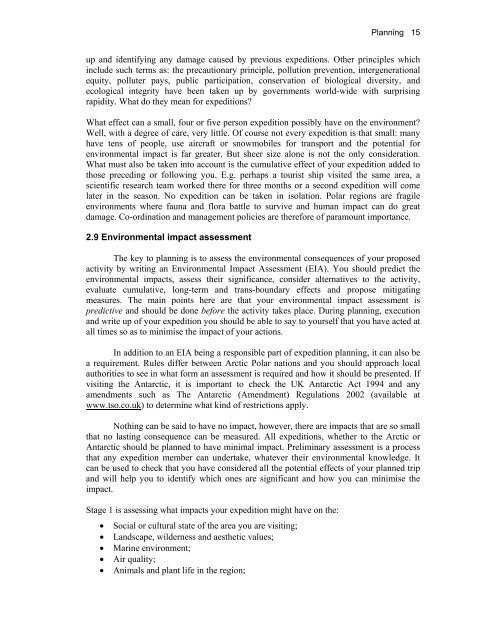Edited by Rachel Duncan 4th Edition ISBN 0-907649-91-2 London ...
Edited by Rachel Duncan 4th Edition ISBN 0-907649-91-2 London ...
Edited by Rachel Duncan 4th Edition ISBN 0-907649-91-2 London ...
You also want an ePaper? Increase the reach of your titles
YUMPU automatically turns print PDFs into web optimized ePapers that Google loves.
Planning 15<br />
up and identifying any damage caused <strong>by</strong> previous expeditions. Other principles which<br />
include such terms as: the precautionary principle, pollution prevention, intergenerational<br />
equity, polluter pays, public participation, conservation of biological diversity, and<br />
ecological integrity have been taken up <strong>by</strong> governments world-wide with surprising<br />
rapidity. What do they mean for expeditions?<br />
What effect can a small, four or five person expedition possibly have on the environment?<br />
Well, with a degree of care, very little. Of course not every expedition is that small: many<br />
have tens of people, use aircraft or snowmobiles for transport and the potential for<br />
environmental impact is far greater. But sheer size alone is not the only consideration.<br />
What must also be taken into account is the cumulative effect of your expedition added to<br />
those preceding or following you. E.g. perhaps a tourist ship visited the same area, a<br />
scientific research team worked there for three months or a second expedition will come<br />
later in the season. No expedition can be taken in isolation. Polar regions are fragile<br />
environments where fauna and flora battle to survive and human impact can do great<br />
damage. Co-ordination and management policies are therefore of paramount importance.<br />
2.9 Environmental impact assessment<br />
The key to planning is to assess the environmental consequences of your proposed<br />
activity <strong>by</strong> writing an Environmental Impact Assessment (EIA). You should predict the<br />
environmental impacts, assess their significance, consider alternatives to the activity,<br />
evaluate cumulative, long-term and trans-boundary effects and propose mitigating<br />
measures. The main points here are that your environmental impact assessment is<br />
predictive and should be done before the activity takes place. During planning, execution<br />
and write up of your expedition you should be able to say to yourself that you have acted at<br />
all times so as to minimise the impact of your actions.<br />
In addition to an EIA being a responsible part of expedition planning, it can also be<br />
a requirement. Rules differ between Arctic Polar nations and you should approach local<br />
authorities to see in what form an assessment is required and how it should be presented. If<br />
visiting the Antarctic, it is important to check the UK Antarctic Act 1994 and any<br />
amendments such as The Antarctic (Amendment) Regulations 2002 (available at<br />
www.tso.co.uk) to determine what kind of restrictions apply.<br />
Nothing can be said to have no impact, however, there are impacts that are so small<br />
that no lasting consequence can be measured. All expeditions, whether to the Arctic or<br />
Antarctic should be planned to have minimal impact. Preliminary assessment is a process<br />
that any expedition member can undertake, whatever their environmental knowledge. It<br />
can be used to check that you have considered all the potential effects of your planned trip<br />
and will help you to identify which ones are significant and how you can minimise the<br />
impact.<br />
Stage 1 is assessing what impacts your expedition might have on the:<br />
• Social or cultural state of the area you are visiting;<br />
• Landscape, wilderness and aesthetic values;<br />
• Marine environment;<br />
• Air quality;<br />
• Animals and plant life in the region;

















